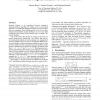Free Online Productivity Tools
i2Speak
i2Symbol
i2OCR
iTex2Img
iWeb2Print
iWeb2Shot
i2Type
iPdf2Split
iPdf2Merge
i2Bopomofo
i2Arabic
i2Style
i2Image
i2PDF
iLatex2Rtf
Sci2ools
112
click to vote
POPL
2016
ACM
2016
ACM
Newtonian program analysis via tensor product
Recently, Esparza et al. generalized Newton’s method—a numerical-analysis algorithm for finding roots of real-valued functions—to a method for finding fixed-points of systems of equations over semirings. Their method provides a new way to solve interprocedural dataflow-analysis problems. As in its real-valued counterpart, each iteration of their method solves a simpler “linearized” problem. One of the reasons this advance is exciting is that some numerical analysts have claimed that “‘all’ effective and fast iterative [numerical] methods are forms (perhaps very disguised) of Newton’s method.” However, there is an important difference between the dataflow-analysis and numerical-analysis contexts: when Newton’s method is used on numerical-analysis problems, multiplicative commutativity is relied on to rearrange expressions of the form “c ∗ X + X ∗ d” into “(c + d) ∗ X.” Such equations correspond to path problems described by regular languages. In...
Related Content
| Added | 09 Apr 2016 |
| Updated | 09 Apr 2016 |
| Type | Journal |
| Year | 2016 |
| Where | POPL |
| Authors | Thomas W. Reps, Emma Turetsky, Prathmesh Prabhu |
Comments (0)

